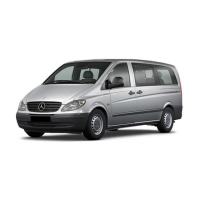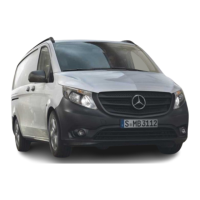icy surface to maintain the same degree of
safety.
Pay particular attention to the state of the
road surface at temperatures around
freezing point. When ice forms on the road
(due to freezing fog, for instance), applying
the brakes can cause a thin layer of water
to form rapidly on the surface of the ice
and tyre grip will be greatly reduced. Drive
with particular care in such weather condi-
tions.
Stopping the vehicle and switching
off the engine
G
Risk of accident
Always switch off the engine and move the
parking brake to the brake position before
leaving the vehicle. Otherwise, the vehicle
could roll away as it would not be secured.
On gradients steeper than 15%:
I
safeguard an unladen vehicle by chock-
ing the front axle
I
additionally secure a laden vehicle at the
rear axle, e.g. using a wheel chock
G
Risk of fire
Make sure that the exhaust system does
not under any circumstances come into
contact with easily ignitable material such
as dry grass or petrol. The material could
otherwise ignite and set the vehicle alight.
G
Risk of accident
Only remove the key from the ignition lock
when the vehicle is stationary since you
cannot steer the vehicle with the key re-
moved.
Never leave children unsupervised in the ve-
hicle. They could release the parking brake.
This could lead to a serious or fatal acci-
dent.
! When the vehicle is parked, always remove
the key to prevent the battery from becoming
discharged.
E Stop the vehicle.
E Shift the manual transmission into neu-
tral or the automatic transmission to
position P.
E Depress the parking brake.
i On steep slopes, turn the front wheels to-
wards the kerb.
! When the coolant temperature is very high,
e.g. after climbing a long uphill gradient, allow
the engine to idle for about two minutes before
switching it off, so that it can return to its nor-
mal operating temperature.
This allows the coolant temperature to return
to normal again.
E To switch off the engine: turn the key
to position 0 in the ignition lock and re-
move it.
The immobiliser is activated.
E If necessary, secure an unladen vehicle
at the front axle and a laden vehicle at
the rear axle to prevent it from rolling
away, e.g. using a chock.
Controls
Driving and parking
176
3
Nur fuer internen Gebrauch

